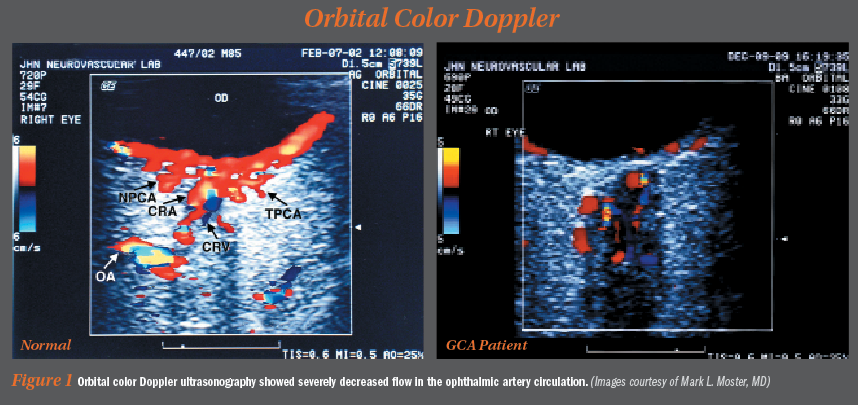Article
Oral vs. IV steroids for giant cell arteritis
Intravenous methylprednisolone may prevent visual loss and occasionally achieve visual recovery in patients with giant cell arteritis.
Take Home
Intravenous methylprednisolone may prevent visual loss and occasionally achieve visual recovery in patients with giant cell arteritis.
By Lynda Charters; Reviewed by Mark L. Moster, MD
Philadelphia-Treating giant cell arteritis (GCA) requires rapid recognition of the disease, which may appear without the usual systemic symptoms. When vision is affected, immediate treatment is needed to prevent further vision loss and occasionally achieve some visual recovery. Intravenous steroids administered during a period of hospitalization may be key to saving vision, according to Mark L. Moster, MD.
Case report
Dr. Moster-professor of neurology and ophthalmology, Wills Eye Hospital, Thomas Jefferson University School of Medicine, Philadelphia-related the case of an 82-year-old man with intermittent flashes and rust-colored vision in the right eye that lasted for seconds to minutes but persisted over 9 days. On the day of presentation, the vision went black, cleared, and was followed by a grey blur over the central visual field. None of the classic symptoms of GCA-such as headache, jaw claudication, decreased appetite, polymyalgia rheumatica, or malaise-were present. The patient had a past medical history of hypertension and hyperlipidemia, coronary artery disease, prostate and colon cancers, and myelodysplastic syndrome.

At presentation, the visual acuity (VA) in the right eye was 20/400 with dyschromatopsia, an afferent pupillary defect, and a superior visual field defect. The optic nerves appeared normal.
Laboratory evaluation showed a markedly elevated erythrocyte sedimentation rate (119 mm/hr) and C-reactive protein (6.9 mg/dl, normal <0.8 mg/dl) and a normal platelet count. Orbital color Doppler ultrasonography showed severely decreased flow in the ophthalmic artery circulation (Figure 1).
Treatment was started immediately with intravenous methylprednisolone 250 mg every 6 hours for 3 days. Biopsy of the temporal artery showed chronic vasculitis with intimal fibrosis consistent with GCA.
Two days after the start of treatment, his symptoms improved, and the VA was 20/40. The patient was discharged and 60 mg of oral prednisone/day was prescribed with vitamin D, calcium, and esomeprazole (Nexium, AstraZeneca). At a follow-up visit at week 4, the vision was 20/25+ with a trace afferent pupillary defect and a minor visual field defect in the right eye. Laboratory tests returned to normal levels, according to Dr. Moster.
Oral or IV steroids?
“This was a very strong success story in this patient with GCA. Would this patient have done as well on oral steroids?” Dr. Moster asked.
When confronted with a patient with GCA, the challenges are to prevent further visual loss, promote visual recovery when possible, and evaluate the ultimate disease course, he said. Currently, 14-20% of patients with GCA lose vision. This is in marked contrast to the 30% to 60% rates of vision loss before the use of steroids in these patients.
“GCA with visual symptoms is a medical emergency,” Dr. Moster emphasized. Unilateral vision loss occurs rapidly, i.e., in hours to days, and from 50% to 75% of patients will lose vision in the fellow eye with 2 weeks if left untreated.
There is not a great deal of evidence to show an added benefit of intravenous methylprednisolone therapy over oral steroid therapy.
“The case for intravenous therapy to prevent disease progression is that emergent treatment is needed. Intravenous therapy is more efficient than handing an elderly patient an outpatient oral prescription. There is immediate compliance, and most medications act faster and are more potent when administered intravenously. Patient tolerance of intravenous methylprednisolone is the same as with oral steroids,” Dr. Moster said.
The argument in favor of oral steroids is that further vision loss may occur with either route of administration and oral treatment is more convenient, he added.
The benefits of either route for visual recovery are unclear, with some studies reporting greater visual recovery with intravenous administration, while others show no difference in visual recovery between the two.
Dr. Moster suggested that perhaps the early treatment is key to any visual recovery, as one study reported more visual recovery when treated within 1 day than when treated later (58% vs. 6%, respectively), regardless of route of treatment. Regarding the clinical course of GCA, one study found that high-dose intravenous steroids might have a long-term benefit in that patients can be weaned faster and after steroid removal there were fewer relapses, he noted.
Dr. Moster also said he views hospitalization with administration of IV steroids as a benefit.
“Hospitalization allows time to deal with comorbidities, perform a temporal artery biopsy and other tests, evaluate the patient for osteoporosis, and most importantly, educate the patient about long-term treatment with steroids,” he said. However, intravenous steroids are not a panacea and patients can progress despite this treatment.
The current consensus regarding GCA, according to Dr. Moster, is that patients with transient or persistent visual loss need immediate treatment by either the intravenous or oral route.
Dr. Moster recommends hospitalization with intravenous methylprednisolone 1 gram/day (250 mg every 6 hours) for 3 days, with the first dose administered in the emergency room. After discharge, he prescribes prednisone 1 mg/kg/day.
He advised that in patients without visual loss, oral or intravenous steroids can be prescribed. In patients with mild GCA (mild polymyalgia and headache) but no vision loss or jaw claudication, he advises 40 mg/day of an oral steroid. However in the presence of neurologic or visual symptoms, patients should receive 80 to 100 mg/day.
“Importantly, don’t wait for the biopsy results to start steroids because patients can rapidly loss vision,” he said.
After the first treatment, the steroids should be tapered slowly over months to years but certainly not until the symptomatology and laboratory values return to normal. Treatment should be in coordination with an internist and/or rheumatologist.
Mark L. Moster, MD
Dr. Moster has no financial interest in any aspect of this report.
Newsletter
Don’t miss out—get Ophthalmology Times updates on the latest clinical advancements and expert interviews, straight to your inbox.




